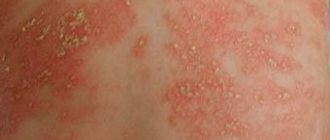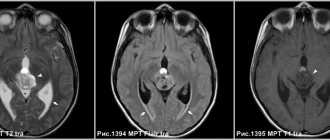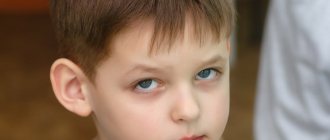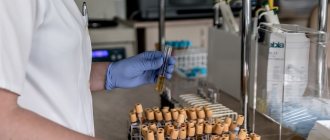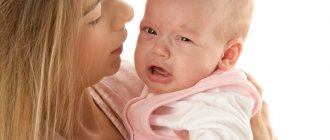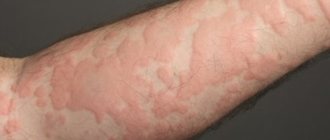Based on the condition of the skin, you can determine whether there are any disturbances in the functioning of the body. Rashes can be different: small red, dotted, spotty, colorless, watery, pustular, itchy, in the form of tubercles and nodular formations. Skin rashes appear much more often in children compared to adults. As a rule, this is due to the influence of external factors on the skin (sunlight, temperature, humidity, toxic and chemical substances, etc.). Internal processes and diseases also affect the skin.
If a skin rash appears in a child, you should consult a pediatric dermatologist. The First Children's Medical Center offers the services of qualified pediatric dermatologists in Saratov: with us you can not just get a doctor's consultation, but undergo all the necessary examinations and obtain opinions from related specialists. A timely visit to the doctor will allow you to find out the cause of the rash, eliminate it and eliminate the risk of relapse or the development of any complications.
Causes of rashes
The reasons are physiological, which are provided by a natural response to an internal process in the body. There may also be pathological causes that develop against the background of:
- disorders under the influence of parasites;
- chemical and toxic substances;
- metabolic disorders;
- lack of certain vitamins;
- dysbacteriosis;
- gastrointestinal and renal function disorders;
- external and internal factors.
As a result, we can conclude that rashes in childhood do not appear without a reason.
It seems to parents that all rashes are almost the same. However, there is a primary rash, which formed first, and a secondary one, which developed over time, instead of or near the primary one.
Newborn acne
Acne, that is, pimples, can appear on a newborn's face: usually on the cheeks, nose and forehead. Just like teenage or adult acne, newborn acne appears as red or white bumps that can appear two to four weeks after birth. There is no way to prevent acne in babies, but over time the acne will go away without leaving a scar. One of the causes of acne is considered to be the overactive work of the sebaceous glands on the child’s skin, caused by the specific action of maternal hormones (androgens).
Types of rashes
Various childhood diseases manifest themselves as primary symptoms in combination with secondary symptoms. The initial rash varies. Equally important is the quick reaction of the parents and the determination of what formation has formed on the child’s body:
- Tuberous. Any detail of such a rash is located deep in the dermis, in other words, the rash is not superficial. There is no cavity, there is a small protrusion in the form of a tubercle, the color of the skin may change to red or purple.
- Blisters. This is what people call almost any formation on the skin. However, in reality, the blister is a round, pink formation that lacks a cavity and contents. A real blister is short-lived, it can last from a couple of minutes to a couple of hours, then disappears without a trace. As an example, we can recall a nettle burn.
- Papular eruptions. This rash is also called nodular, since the papules are similar in appearance to nodules, which differ in shade from the normal color of the skin. Papular rash can be superficial or deep, and papules can disappear without a trace.
- Vesicular rash. This rash appears as blisters on the skin. There may be a serous, colorless or serous-bloody liquid secretion inside. Vesicles can be single or fused, forming a formation with numerous chambers. Opened vesicles leave erosion on the skin, the size of which is equal to the area of the bottom of the vesicle.
- Bullous. This type of rash also appears in the form of vesicles, but compared to vesicles, the bulla has a more impressive size - at least 5 mm in diameter. Such blisters may, like vesicles, contain serous or serous-bloody liquid contents.
- Pustular. Pustules are a pustular rash. It can be superficial or located deep in the skin. The opening of superficial pustules passes without a trace. If medium and deep pustules (boils, carbuncles) are opened, unsightly scars may occur.
- Spot-like rashes. This type of rash does not appear on the surface of the skin, but is characterized by a change in shade in some areas of the body. Such rashes can be vascular or petechial.
- Roseola. This is the name for rashes that appear in many pathologies of an infectious nature. All elements of the rash are pink or moderately reddish in color. The structure of roseola resembles specks. When the skin is stretched and pressure is applied, the rash turns pale and disappears for a while.
- Hemorrhagic rashes. This type of rash appears as red blood spots that form in the area where the blood vessel burst. When the skin is stretched, hemorrhage does not disappear.
Secondary rashes also vary. It manifests itself in the form of scabs, which are accompanied by the transformation of elements of the primary rash (usually vesicular or pustular) into crusts after opening. The development of cracks, erosions, detachments of epithelial cells, abrasions, scars and ulcers is also often observed as secondary manifestations.
Scabies
Scabies is a rash caused by microscopic mites that burrow into the skin and lay eggs. After this, the child's scabies rash usually appears within two to four weeks. Scabies occurs in both infants and older children, but it manifests itself in different ways. In infants, it appears as fluid-filled pimples, and the rash usually occurs only on the palms of the hands and soles of the feet. In older children, you may notice small bumps next to reddened areas of the skin - the itch burrows made by the mite. If you suspect your child has scabies, consult a doctor. The specialist will be able to make a scraping to exclude or confirm the disease and, if necessary, prescribe treatment. Because scabies is a contagious dermatological disease, your doctor may recommend treatment for the entire family.
Where skin rashes may appear
Small red rashes are the most common type of rash that can appear in children at different ages, especially in early childhood, preschool and primary school.
Small rashes without suppuration can appear on the scalp, face, armpits, shoulders, abdomen, back, buttocks, perineum, groin. Such rashes are typical for allergies (food, medication or cosmetic). They can also be the result of overheating and poor hygiene. This leads to diaper rash and prickly heat. In babies of the first year of life, the rash may cover the head, since thermoregulation is carried out through the skin in this area of the body.
The skin of the face may become covered with a red rash due to certain pathologies of a viral nature. In the case where the child was not given any suspicious new foods or medications, or there were no changes in lifestyle, rashes may still appear on the face. In this case, you should measure your temperature and consult a pediatrician.
Red rashes of various sizes and types can appear on the arms and legs of children against the background of infectious diseases of a viral and bacterial nature, scarlet fever, measles, leukemia.
It is quite difficult to detect colorless rashes, although over time they appear more pronounced. Most often, this type of rash indicates the initial stage of allergy development. Almost imperceptible rashes without a specific color or too pale, covering the body, can create a feeling of roughness when touched. This is similar to goosebumps running across the skin during fear or chills. The rashes are located close to each other and can be widespread.
Watery rashes are a clear sign of herpetic and pustular infectious diseases, allergies, insect bites and sunburn.
Bubbles filled with liquid contents may appear in the following places:
- in the facial area (nasolabial triangle, lips, nose);
- in the area of the sides and limbs, genitals, groin and inner thighs;
- in the anal area.
In this case, the development of an infection of pustular or herpetic origin can be suspected. In almost the same way, an allergic reaction to the use of skin care products occurs upon contact with chemicals and toxins, which cause a local reaction reminiscent of a chemical burn.
Due to prolonged exposure to sunlight, blistering lesions may appear on the skin, and the skin will be red and slightly swollen.
The appearance of blisters on the skin in the area of the hands and feet may indicate dyshidrosis - blockage of the sweat glands. The palms and heels may become covered with blisters due to the development of certain pathologies of a fungal nature.
Diaper rash
Diaper rash, or diaper rash, is a reddish rash that appears on your baby's skin under and around the diaper. The structure can be either flat or convex. Can cause significant discomfort to the baby. Diaper rash can occur if your baby spends too much time in a wet diaper or if the diaper is too small. If the cause of diaper rash is eliminated, it usually goes away in three to four days. Therefore, try to change your baby's diaper as often as possible. Clean the area under the diaper with wet wipes or a cloth soaked in water and, if possible, give your baby air baths. It is also recommended to use diaper rash cream to create a protective barrier on the skin.
Atopic dermatitis
Atopic dermatitis (or itchy rash) sometimes appears in babies after the first month of life. You may notice your baby's cheeks are red and there are red, dry, flaky patches of skin on the elbow or behind the knees. In infants, atopic dermatitis appears more often on the body than on the face. The rash can be mild, but can also be accompanied by severe itching and cause great discomfort to the baby. If you suspect your baby has atopic dermatitis, consult your pediatrician - he will be able to prescribe an ointment or cream for treatment and care. To get rid of this unpleasant condition or prevent its recurrence, use mild, unscented soap to care for your baby, choose clothes made of soft fabric, and bathe your baby no more than three times a week. To wash children's clothes, use unscented products.
Purulent rashes
Pustular purulent rashes are characteristic of bacterial infections. Most often, such diseases develop under the influence of Staphylococcus aureus. Sometimes the reason may lie in the influence of epidermal staphylococcus and streptococcus, as well as some other microbes, on the body.
A similar rash can appear due to microtraumas on the skin, scratches and wounds that allow microbes to penetrate inside. If the rashes are itchy and itchy at first, and the baby begins to scratch them, a bacterial infection occurs and pustules appear.
The formation of pustules in the area of the knees and elbows in childhood is possible with frequent trauma to the skin due to numerous falls. The formation of deep abscesses is called furunculosis.
Crusts on the head
Crusts, or seborrheic dermatitis, look like dense scaly growths on the baby's head. They can also form on the neck, armpits, behind the ears and even in the groin area. Sometimes you may also notice redness or a rash. Usually the crusts disappear on their own within a few months. If the crusts are present only on the head, try to gradually comb them out with a soft brush when you wash your baby's hair. Sometimes you may need a special shampoo, which can be prescribed by your pediatrician.
What parents need to do
To assess the situation, parents need to examine the child’s skin by undressing him. It is necessary to determine the nature of the rash (vesicle, pustule, papule, etc.), and its area. It is necessary to remember and analyze the situation preceding the appearance of a rash on the body.
The next step is to measure the temperature, examine the throat and tonsils, and identify other signs if any. You need to decide whether to call a doctor at home or visit a medical facility yourself.
What not to do if a rash appears
Prohibited actions:
- squeezing out pustules;
- scratching the rash;
- self-treatment;
- opening of bubbles;
- applying brightly colored products to the skin, as this complicates diagnostic measures.
Do not forget that some infectious diseases accompanied by the appearance of skin rashes are contagious. As a result, you should not go to the clinic with your child, since you can infect someone while waiting your turn. In such a situation, it is recommended to call a doctor home.
How to avoid allergies in children?
Preventive measures will prevent the child from developing an allergic rash. Doctors give the following recommendations:
- Make sure that the baby does not come into contact with the allergen (remove allergenic foods from his diet; if necessary, change baby powder, soap or dishwashing liquid.
- Maintain order in his room, regularly do wet cleaning.
- If there are pets in the house, keep them clean.
- Strengthen the baby’s immunity (walk more often, play sports).
- Do not violate your doctor’s recommendations for taking medications.
Treatment of urticaria
Pharmaceutical drugs used to treat urticaria should be taken as recommended by your doctor. The best treatment for this condition is to know and avoid trigger factors. The hives will probably go away on their own. But at the same time, medical supervision is a prerequisite to exclude the development of complications.
Treatment for urticaria in children includes:
- taking antihistamines to reduce the rash;
- eliminating foods that cause hives;
- prescribing diuretics to eliminate severe edema;
- using antipruritic ointments to relieve the condition.
- in some situations, hormones are used (topically and by injection).
You need to keep a diary about what the child does and eats. This approach allows us to identify predisposing factors and eliminate them.
Gradually, one can narrow down the real causes and respond accordingly.
With such a complication as Quincke's edema, coughing attacks appear and breathing becomes difficult. In this case, urticaria in children requires emergency care.
Young children often experience swelling of the gastrointestinal mucosa, which is accompanied by vomiting. In severe cases, damage to the nervous system and brain occurs. Such conditions are dangerous to health and life, so delaying a visit to the doctor is unacceptable.
Most children switched to a hypoallergenic diet recover quickly and recover even without medication.
Ringworm
Ringworm is a skin disease caused by a fungus and manifests itself in lesions of different sizes: oval, round or with clear boundaries. Such lesions can appear on the scalp and throughout the baby’s body. With lichen, brittleness and hair loss are observed if they are in the area of infection. The infection is transmitted from person to person and even from animals to people. If a child has ringworm, no one in the family should use his brush, hair accessories, or wear his hats. Ringworm can sometimes be confused with dandruff or crusty scalp. If your child is over a year old and has a scaly rash on the scalp, it is most likely ringworm rather than scabs. A doctor can make an accurate diagnosis. If you suspect your child has ringworm, contact a specialist. By following your doctor's instructions, you will most likely say goodbye to shingles in about a week. As a rule, external agents are prescribed for treatment.
Symptoms of urticaria
Hives appear as red spots, swelling and blisters. The main symptoms are itching and burning sensation on the skin. Symptoms may progress and spread to other areas of the body.
Additional symptoms of urticaria in children include:
- nausea and vomiting;
- increased body temperature;
- discomfort in the joints.
The spots can be as small as a dot or the size of a coin. Typically, spots appear and disappear within a few hours. However, chronic hives can last for more than 6 weeks.
Impetigo
Impetigo is a contagious skin disease that usually affects the nose, mouth and ears. The infection is caused by staph or streptococcal bacteria, and a baby who gets impetigo will need to take antibiotics. The doctor will order a test to find out what bacteria is causing the infection and then determine the course of treatment. Impetigo is contagious as long as the child has the rash, which sometimes forms blisters and eventually crusts over. At this stage, you need to avoid the baby's contact with other children. Avoid touching the rash to prevent the infection from spreading.
